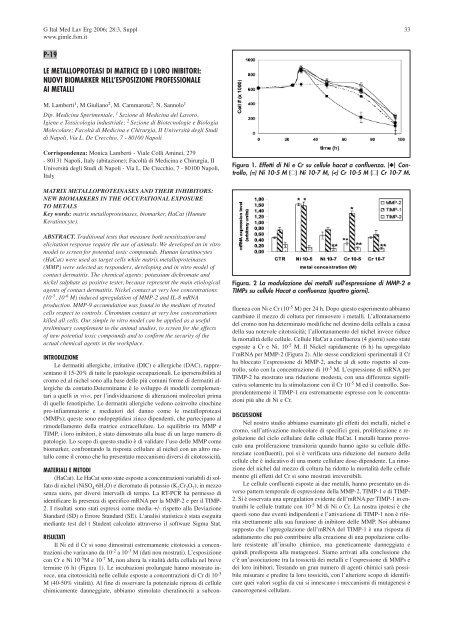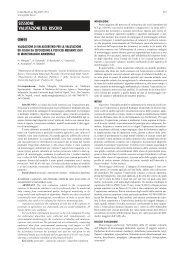Indice - Giornale Italiano di Medicina del Lavoro ed Ergonomia ...
Indice - Giornale Italiano di Medicina del Lavoro ed Ergonomia ...
Indice - Giornale Italiano di Medicina del Lavoro ed Ergonomia ...
You also want an ePaper? Increase the reach of your titles
YUMPU automatically turns print PDFs into web optimized ePapers that Google loves.
G Ital M<strong>ed</strong> Lav Erg 2006; 28:3, Suppl 33<br />
www.gimle.fsm.it<br />
P-19<br />
LE METALLOPROTEASI DI MATRICE ED I LORO INIBITORI:<br />
NUOVI BIOMARKER NELL’ESPOSIZIONE PROFESSIONALE<br />
AI METALLI<br />
M. Lamberti1 , M Giuliano2 , M. Cammarota2 , N. Sannolo1 Dip. Me<strong>di</strong>cina Sperimentale, 1 Sezione <strong>di</strong> Me<strong>di</strong>cina <strong>del</strong> <strong>Lavoro</strong>,<br />
Igiene e Tossicologia industriale; 2 Sezione <strong>di</strong> Biotecnologie e Biologia<br />
Molecolare; Facoltà <strong>di</strong> Me<strong>di</strong>cina e Chirurgia, II Università degli Stu<strong>di</strong><br />
<strong>di</strong> Napoli, Via L. De Crecchio, 7 - 80100 Napoli<br />
Corrispondenza: Monica Lamberti - Viale Colli Aminei, 279<br />
- 80131 Napoli, Italy (abitazione); Facoltà <strong>di</strong> Me<strong>di</strong>cina e Chirurgia, II<br />
Università degli Stu<strong>di</strong> <strong>di</strong> Napoli - Via L. De Crecchio, 7 - 80100 Napoli,<br />
Italy<br />
MATRIX METALLOPROTEINASES AND THEIR INHIBITORS:<br />
NEW BIOMARKERS IN THE OCCUPATIONAL EXPOSURE<br />
TO METALS<br />
Key words: matrix metalloproteinases, biomarker, HaCat (Human<br />
Keratinocyte).<br />
ABSTRACT. Tra<strong>di</strong>tional tests that measure both sensitization and<br />
elicitation response require the use of animals. We develop<strong>ed</strong> an in vitro<br />
mo<strong>del</strong> to screen for potential toxic compounds. Human keratinocytes<br />
(HaCat) were us<strong>ed</strong> as target cells while matrix metalloproteinases<br />
(MMP) were select<strong>ed</strong> as responders, developing and in vitro mo<strong>del</strong> of<br />
contact dermatitis. The chemical agents: potassium <strong>di</strong>chromate and<br />
nickel sulphate as positive tester, because represent the main etiological<br />
agents of contact dermatitis. Nickel contact at very low concentrations<br />
(10 -5 , 10 -6 M) induc<strong>ed</strong> upregulation of MMP-2 and IL-8 mRNA<br />
production. MMP-9 accumulation was found in the me<strong>di</strong>um of treat<strong>ed</strong><br />
cells respect to controls. Chromium contact at very low concentrations<br />
kill<strong>ed</strong> all cells. Our simple in vitro mo<strong>del</strong> can be appli<strong>ed</strong> as a useful<br />
preliminary complement to the animal stu<strong>di</strong>es, to screen for the effects<br />
of new potential toxic compounds and to confirm the security of the<br />
actual chemical agents in the workplace.<br />
INTRODUZIONE<br />
Le dermatiti allergiche, irritative (DIC) e allergiche (DAC), rappresentano<br />
il 15-20% <strong>di</strong> tutte le patologie occupazionali. Le ipersensibilità al<br />
cromo <strong>ed</strong> al nichel sono alla base <strong>del</strong>le più comuni forme <strong>di</strong> dermatiti allergiche<br />
da contatto.Determinante è lo sviluppo <strong>di</strong> mo<strong>del</strong>li complementari<br />
a quelli in vivo, per l’in<strong>di</strong>viduazione <strong>di</strong> alterazioni molecolari prima<br />
<strong>di</strong> quelle fenotipiche. Le dermatiti allergiche v<strong>ed</strong>ono coinvolte citochine<br />
pro-infiammatorie e me<strong>di</strong>atori <strong>del</strong> danno come le metalloproteasi<br />
(MMPs); queste sono endopeptidasi zinco <strong>di</strong>pendenti, che partecipano al<br />
rimo<strong>del</strong>lamento <strong>del</strong>la matrice extracellulare. Lo squilibrio tra MMP e<br />
TIMP, i loro inibitori, è stato <strong>di</strong>mostrato alla base <strong>di</strong> un largo numero <strong>di</strong><br />
patologie. Lo scopo <strong>di</strong> questo stu<strong>di</strong>o è <strong>di</strong> validare l’uso <strong>del</strong>le MMP come<br />
biomarker, confrontando la risposta cellulare al nichel con un altro metallo<br />
come il cromo che ha presentato meccanismi <strong>di</strong>versi <strong>di</strong> citotossicità.<br />
MATERIALI E METODI<br />
(HaCat). Le HaCat sono state esposte a concentrazioni variabili <strong>di</strong> solfato<br />
<strong>di</strong> nichel (NiSO 4 ⋅6H 2 O) e <strong>di</strong>cromato <strong>di</strong> potassio (K 2 Cr 2 O 7 ), in mezzo<br />
senza siero, per <strong>di</strong>versi intervalli <strong>di</strong> tempo. La RT-PCR ha permesso <strong>di</strong><br />
identificare la presenza <strong>di</strong> specifico mRNA per la MMP-2 e per il TIMP-<br />
2. I risultati sono stati espressi come me<strong>di</strong>a +/- rispetto alla Deviazione<br />
Standard (SD) o Errore Standard (SE). L’analisi statistica è stata eseguita<br />
me<strong>di</strong>ante test <strong>del</strong> t Student calcolato attraverso il software Sigma Stat.<br />
RISULTATI<br />
Il Ni <strong>ed</strong> il Cr si sono <strong>di</strong>mostrati estremamente citotossici a concentrazioni<br />
che variavano da 10 -2 a 10 -3 M (dati non mostrati). L’esposizione<br />
con Cr e Ni 10 -5 M e 10 -7 M, non altera la vitalità <strong>del</strong>la cellula nel breve<br />
termine (6 h) (Figura 1). Le incubazioni prolungate hanno mostrato invece,<br />
una citotossicità nelle cellule esposte a concentrazioni <strong>di</strong> Cr <strong>di</strong> 10 -5<br />
M (40-50% vitalità). Al fine <strong>di</strong> osservare la potenziale ripresa <strong>di</strong> cellule<br />
chimicamente danneggiate, abbiamo stimolato cheratinociti a subcon-<br />
Figura 1. Effetti <strong>di</strong> Ni e Cr su cellule hacat a confluenza. (◆) Controllo,<br />
(=) Ni 10-5 M (●) Ni 10-7 M, (
















